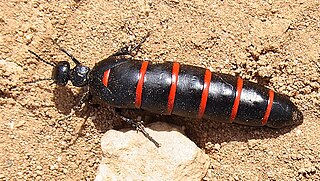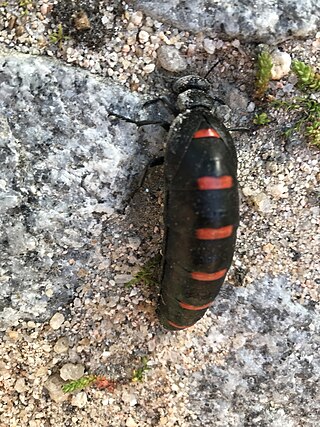
Cantharidin is an odorless, colorless fatty substance of the terpenoid class, which is secreted by many species of blister beetles. Its main current use in pharmacology is treating molluscum contagiosum and warts topically. It is a burn agent and poisonous in large doses, and has been historically used as aphrodisiacs. In its natural form, cantharidin is secreted by the male blister beetle, and given to the female as a copulatory gift during mating. Afterwards, the female beetle covers her eggs with it as a defense against predators.

Blister beetles are beetles of the family Meloidae, so called for their defensive secretion of a blistering agent, cantharidin. About 7,500 species are known worldwide. Many are conspicuous and some are aposematically colored, announcing their toxicity to would-be predators.

Meloe is a genus of blister beetles commonly referred to as oil beetles. The name derives from their defensive strategy: when threatened by collectors or predators they release oily droplets of hemolymph from their joints. This fluid is bright orange and contains cantharidin, a poisonous chemical compound. Wiping the chemical on skin can cause blistering and painful swelling of the skin. This defensive strategy is not exclusive to this genus; all meloids possess and exude cantharidin upon threat.

Cerocoma is a Palearctic genus of blister beetle, whose biology is poorly known. As in other members of the family, these insects are hypermetamorphic. Larval hosts of few species were described. Imagines show distinct sexual dimorphism in the feeding apparatus and the antennae. All species in this genus have aposematic colouration.
Nemognatha chrysomeloides is a species of oil beetle (Meloidae) endemic to Central and South America.

Berberomeloe majalis, the red-striped oil beetle, is an insect in the genus Berberomeloe, in the family of Blister Beetles. It is native to the western Mediterranean Basin.

Meloinae is a subfamily of beetles in the family Meloidae. There are at least 330 described species in Meloinae.
Meloe dianella is a species of blister beetle in the family Meloidae. It is found in North America.

Meloe americanus is a type of blister beetle (Meloidae) found in North America. It is most relevant to the fields of agriculture and veterinary medicine. Adult beetles feed on different types of plants, which could cause crop damage. They also release a fluid containing a chemical that is toxic, and at high concentrations lethal, to mammals. The first instar larvae are uniquely active and mobile, utilizing phoresy and parasitism to feed and mature through their developmental stages.
Meloe barbarus is a species of blister beetle in the family Meloidae. It is found in North America.

Meloe campanicollis is a species of blister beetle in the family Meloidae. It is found in North America.
Meloe occultus is a species of blister beetle in the family Meloidae. It is found in North America.
Meloe niger, the black meloe, is a species of blister beetle in the family Meloidae. It is found in North America.
Meloe dugesi is a species of blister beetle in the family Meloidae. It is found in Central America and North America.
Meloe franciscanus is a species of blister beetle in the family Meloidae. It is found in the deserts of the southwestern United States. The larvae are parasites of bee larvae, eating them and consuming their provisions.
Meloe bitoricollis is a species of blister beetle in the family Meloidae. It is found in North America.

Meloe laevis, the oil beetle, is a species of blister beetle in the family Meloidae. It is found in the Caribbean, Central America, and North America.

Mylabris variabilis is a species of blister beetle belonging to the Meloidae family.

Physomeloe corallifer is a species of blister beetle native to the Iberian Peninsula, it is the only recognised species in the genus Physomeloe.

Berberomeloe castuo, known commonly as the Portuguese red-striped oil beetle, is a species of beetle in the genus of Berberomeloe.












